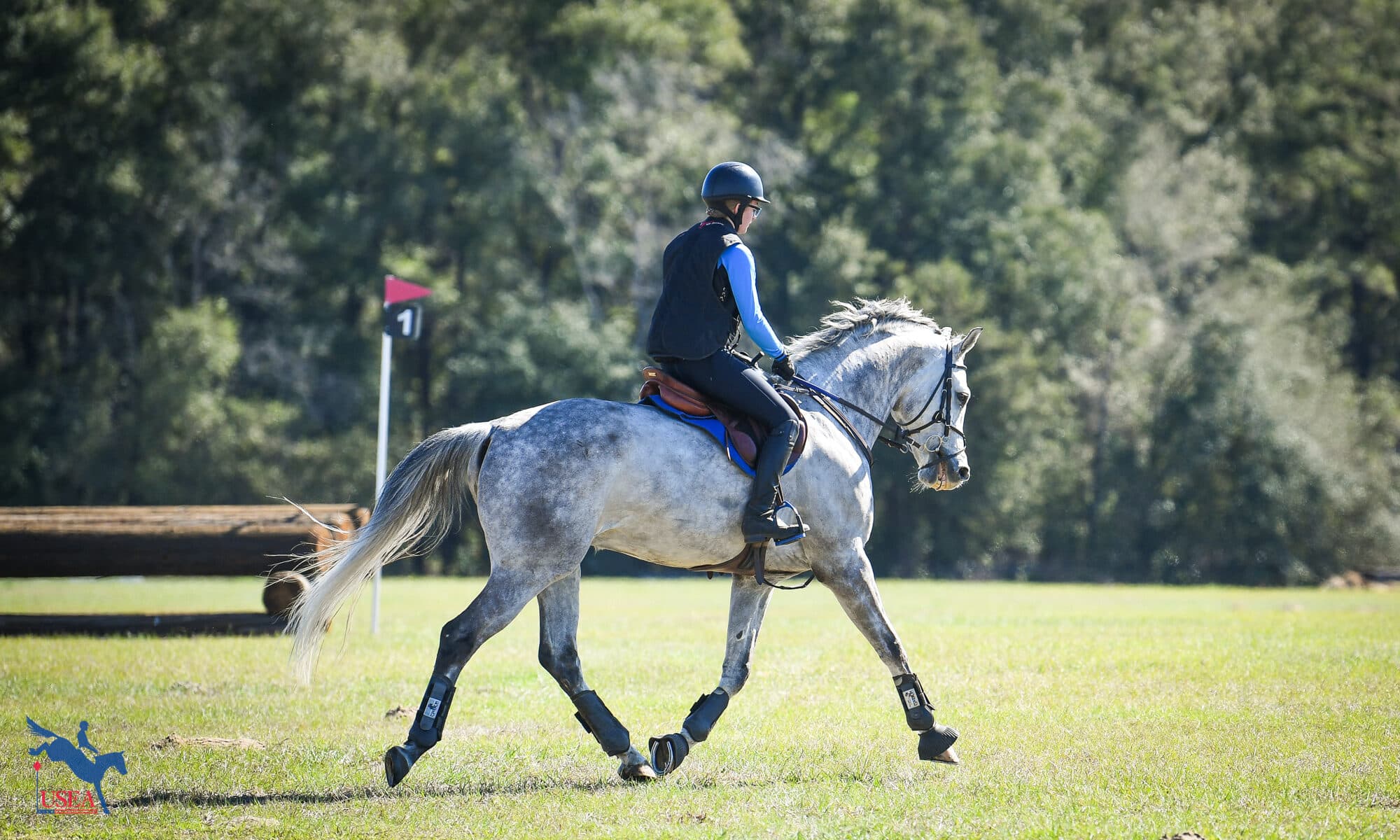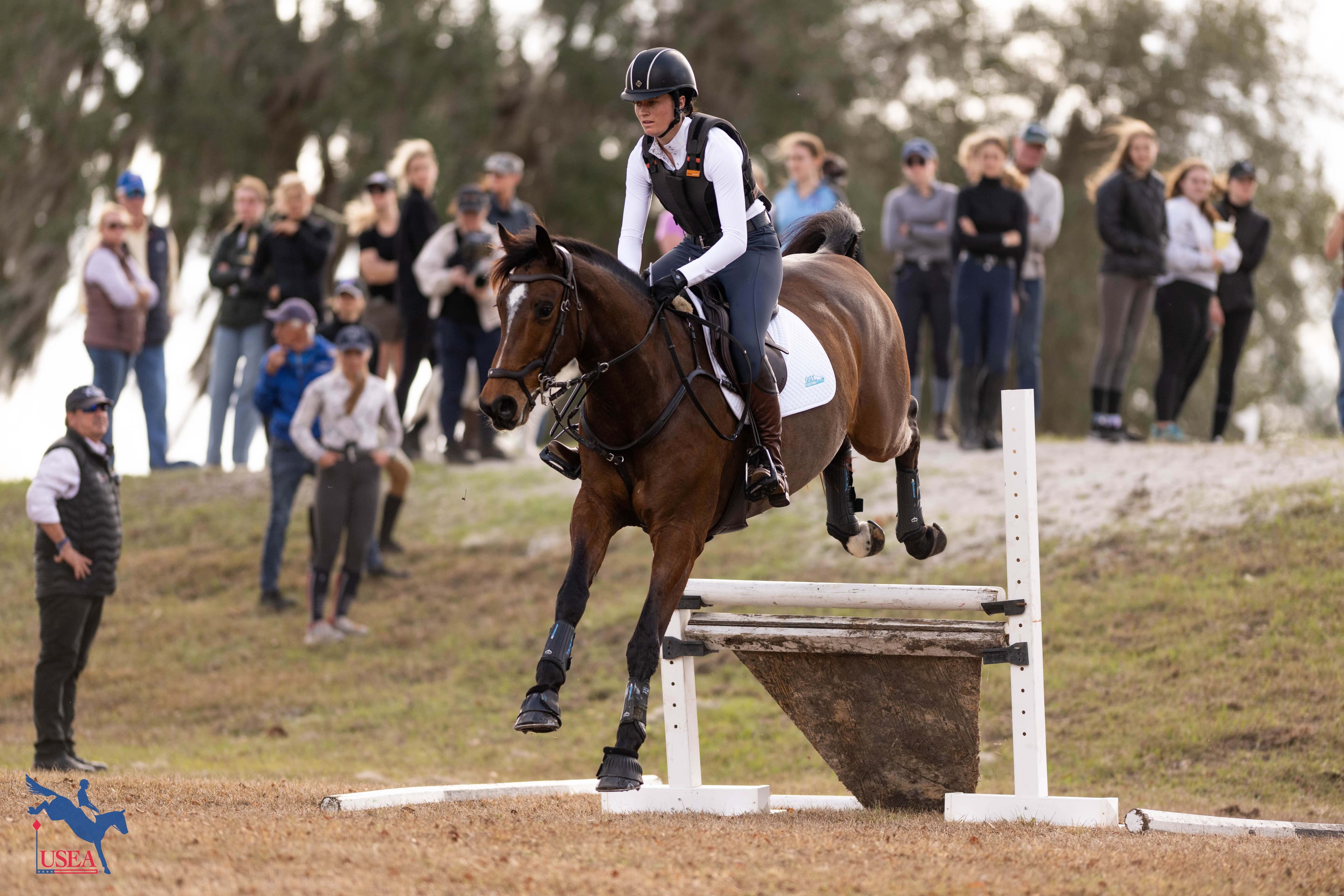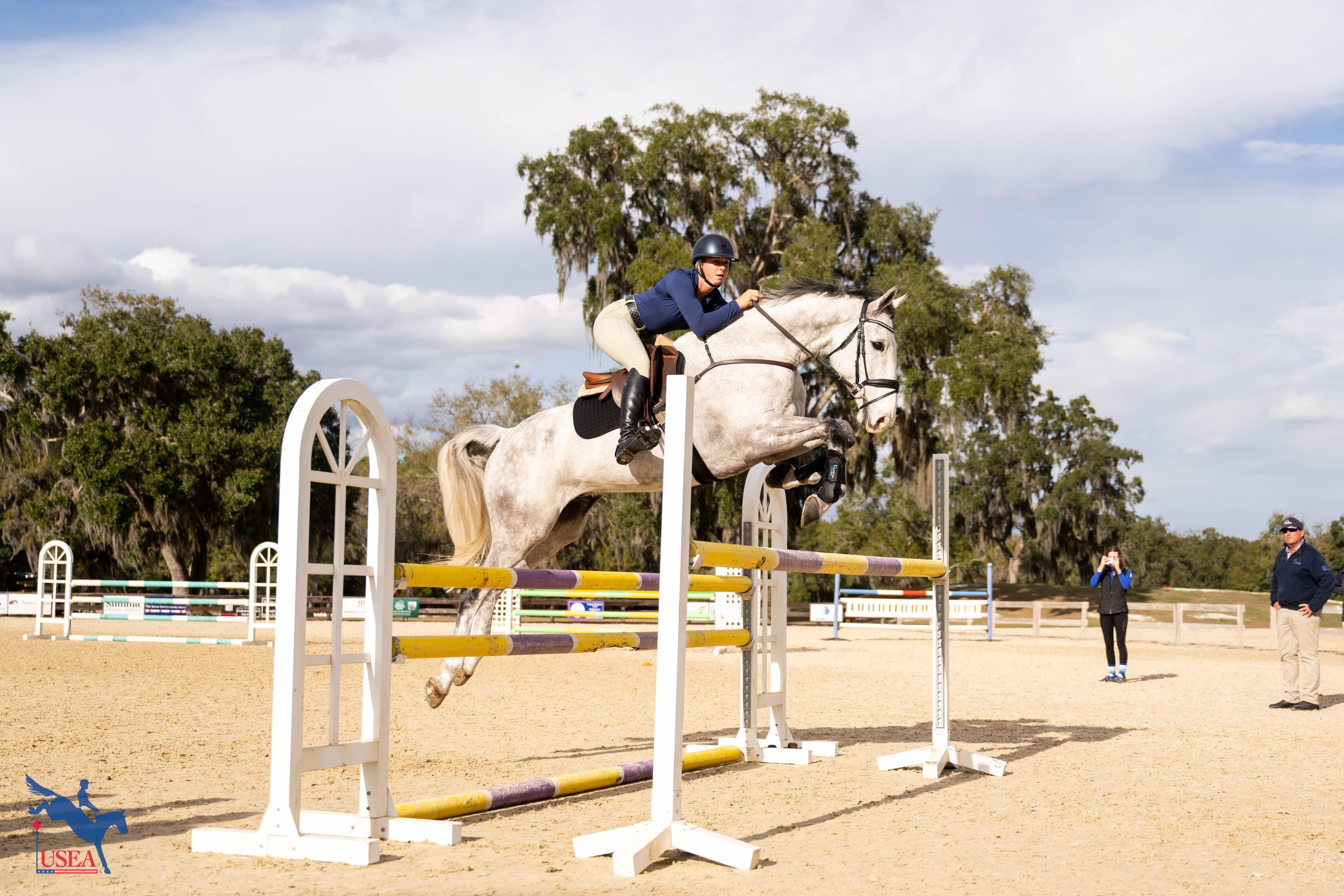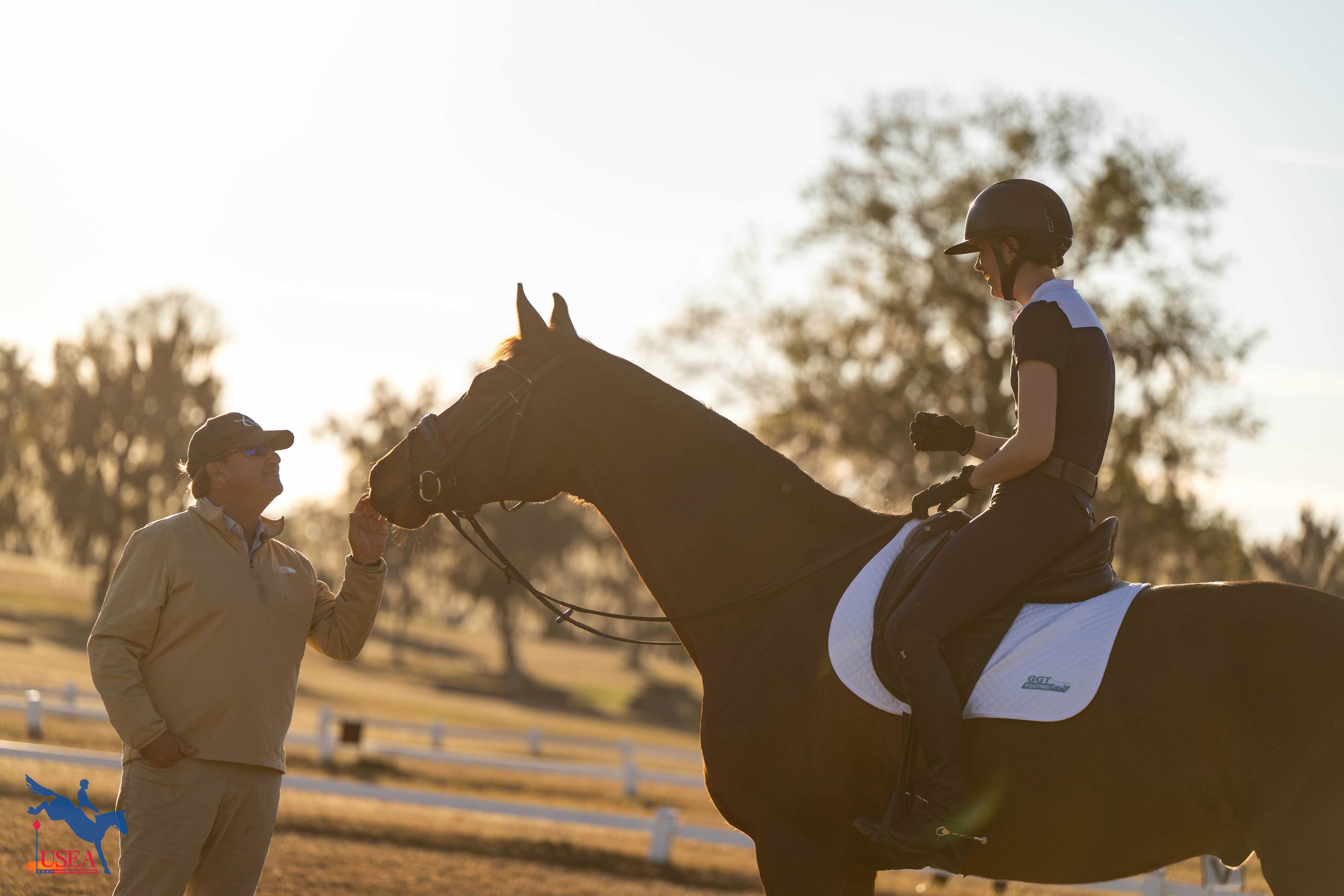Fieldwork for Eventers

One of the important concepts that event riders of all levels should understand, and practice is how the dressage flatwork carries over into the show jumping and cross-country phases. Don’t forget, the word dressage, translated from French, literally means training. A good basis in dressage makes the horse more responsive and pleasant to ride in the eventing jumping phases as well as in the show ring, the hunt field, on the trails, or for whatever else you want to do with your horse. So, while I do enjoy dressage for its own sake, I appreciate it most for how it makes the horse better to ride in the open and to the jumps (which may be why I am an event rider instead of a dressage rider).
The importance of this is illustrated in the USEA Eventing Handbook by the Levels (available to all USEA members as a PDF download in your USEA membership dashboard.)
At the Beginner Novice level, the first rider skill requirement listed for cross-country is:
Understand the link between flatwork and riding cross-country.
At the Novice level, the cross-country rider skill requirements become more detailed. The Handbook states the rider must have the ability to:
Demonstrate a connection between their flatwork and cross-country riding. This connection is the foundation which permits the rider to:
- Maintain and control the canter in the open for sustained intervals and over a variety of changes in terrain.
- Produce and maintain appropriate pace, length of stride, rhythm, balance, and an accurate line for navigating various level-appropriate types of cross-country fences, questions, and changes of terrain.
- Lengthen or shorten the stride while maintaining rhythm, energy, balance, and line of direction.
-Control and/or change the length of stride and balance as appropriate in the approach to a variety of jumps and questions.
Reading on to the higher levels, these requirements as stated in the Handbook apply to every level, but of course demanding a higher standard of sophistication as one moves up the levels. The rider must be able to create the correct canter or gallop needed for each individual fence, using the training from the dressage to be able to influence and adjust the horse’s speed, impulsion, rhythm, balance, and straightness.
For instance, at Modified level, the Handbook states:
The rider’s responsibilities in preparation for every jump is to produce the qualities of a good jumping canter: Appropriate speed, an accurate line of direction, and the required rhythm, energy, and balance.
But how does one get the horse and rider’s flatwork skills to carry over into the cross-country?
This is where fieldwork comes in.
Many event riders spend a lot of time practicing their dressage and taking dressage lessons. They also do regular show jumping schools and lessons. And, usually less often, they have cross-country schools to prepare for their events.
But how much time does the average Beginner Novice, Novice, or Training rider spend practicing out in the open field or on the cross-country course, to ensure that both they and the horse can apply the flatwork to riding in the open? And I don’t mean when they are cross-country schooling or galloping; there is usually a good deal of excitement in both horse and rider about going cross-country, and this is not the ideal time to be trying to master this basic flatwork-cross-country link.
I like to do a lot of flatwork out in the open fields, which I call fieldwork. I will take my horses and students out on the cross-country course often, not to gallop and jump, but rather to practice the basics of flatwork. Everything they do in the dressage arena, the horse and rider should also be able to do out in the open, but with the rider in shorter stirrups and a more forward seat. I am talking about basic skills such as lengthening and shortening stride, bending the horse right, left, going straight, asking the horse to move off the leg laterally, and riding the horse in balance and keeping him light in the bridle.
Of course, this is all done appropriately to the level at which the horse is schooling in the arena. This type of work is where you teach the horse to respond to a similar set of aids whether they are in the dressage ring, show jumping, or out in the open going cross-country, even though stirrup length and rider position will vary with the different phases. Without this important fieldwork link, it is difficult to instill the confidence and control in both horse and rider that is needed to excel in our sport.
When you begin doing fieldwork with your horse, don’t necessarily expect your best dressage work in the early days; field work, like flatwork, requires time, patience, and repetition. Remember, the goal here is not to put the finishing touches on your dressage test, but to train the horse to respond to the aids and do all of the basic flatwork requirements when out in the open or going cross-country. Fieldwork will help give you the tools you need to create the link between our dressage work and riding cross-country.
I use fieldwork with horses and riders of all levels, as soon as they have a good enough foundation in the arena to be safe and in control in the open. I would expect both horse and rider to be used to quietly hacking out (likely with another horse) before progressing to actual fieldwork.
I start by taking the horse (or student) to a nice spot in an open field with good footing. If they are green or nervous, it is helpful to go with another horse doing similar work. I generally use a jumping saddle with stirrups adjusted somewhere halfway between dressage and jumping lengths. Ideally you would like to use a snaffle for the fieldwork, but if your horse is quite strong you may need to use a slightly stronger bit at first. I usually instruct the rider to sit light on the horse; not completely out of the saddle, but not all the way in a dressage seat either—again, somewhere halfway in between. Like the half-seat you might use warming up to show jump. Of course, this will vary according to the needs of the individual horse and rider.
Fieldwork can also be done in full dressage mode, with a dressage saddle and stirrup length and the rider sitting deep. This can be beneficial for teaching the horse to respond in the open and is also helpful at the competition if you are warming up for your dressage test in a field. But for linking the flatwork to the cross-country, I tend to do more of my work in the lighter half-seat.
At first, I will use a fairly level area not much bigger than a dressage ring and start working the horse quietly on the flat. In the beginning the horse will probably be distracted and perhaps tense, but I would keep working, usually at rising trot initially, until the horse is going quietly in a nice rhythm, allowing the rider to control the straightness and balance, and responding willingly to half-halts.
The horse (and rider) should be comfortable at the working trot before you start adding in different exercises or movements. As soon as they are relaxed and responsive, you can start to enlarge the area you are working in and use more terrain. Always go slower down the hills at every gait, and uphill is a great place to ride a bit more forward. Gradually add in more canter work, as well as transitions, both between gaits and within the gait, and perhaps bits of lateral movements. How much you demand and what exercises you use will depend on the horse’s level and temperament.
If the horse becomes tense or unresponsive to the aids, then you go back to quieter exercises until he settles, just as you would if you were schooling in the ring. As a rule, with a nervous or hot horse keep the work very steady and low key. Do a lot of quiet working trot, requiring the horse to stay in a good rhythm and bend correctly, using half halts and subtle transitions within the gait until he becomes more relaxed. On the other hand, if the horse is idle or dull, then using quicker transitions, lateral movements, and changing up the exercises constantly will generally make the horse sharper to the aids and more in front of the leg. So, like you would in the arena, you are constantly adjusting exercises according to how your horse is responding.
You can tailor the fieldwork routine for each individual horse and rider pair in order to produce the best results. You want to get to the point where working in the open is no big deal, with both horse and rider confident and relatively relaxed. With some horses this will come quickly; with others it may take weeks or even months of repetition.
Once you and your horse are proficient doing the flatwork exercises in the field, and the horse is responding suitably to the aids as you lengthen and shorten stride in both trot and canter, you can start to gradually incorporate some quiet galloping into the fieldwork. You should then be able to get up in a galloping position and open up the stride, and then quietly bring the horse back to a more collected jumping type of canter, practicing these transitions over and over until you can do them with ease.
You are training the horse to respond to the aids on the cross-country course by practicing them in a quiet and methodical manner out in the open, but without the adrenalin and excitement of jumping. This adjustability and rideability is not easily taught if you only ask for it when cross-country schooling or competing; consistent training in the open is required for these skills to be truly confirmed. Fieldwork will help develop that all-important link between flatwork and cross-country riding and give you the ability to produce the various high-quality canters appropriate for different cross-country questions. This will be essential to making your cross-country rides safe and successful.
About the USEA Eventing Coaches Program (ECP)
Coaches are essential to the training of riders and horses for safe and educated participation in the sport of eventing. The USEA Eventing Coaches Program (ECP), formerly known as the Instructors’ Certification Program (ICP), was initiated in 2002 to educate all levels of eventing coaches with crucial training principles upon which they can continue to build throughout their teaching careers. ECP offers educational workshops and assessments by which both regular coaches, Level I through Level V, Young Event Horse (YEH) coaches, and Young Event Horse professional horse trainers can become ECP certified. Additional information about ECP’s goals, benefits, workshops, and assessments as well as names and contact information for current ECP certified coaches, YEH coaches, and YEH professional horse trainers are available on the USEA website. Click here to learn more about the USEA Eventing Coaches Program.
The USEA would like to thank Parker Equine Insurance, the United States Pony Clubs, and Strider for their support of the Eventing Coaches Program.














